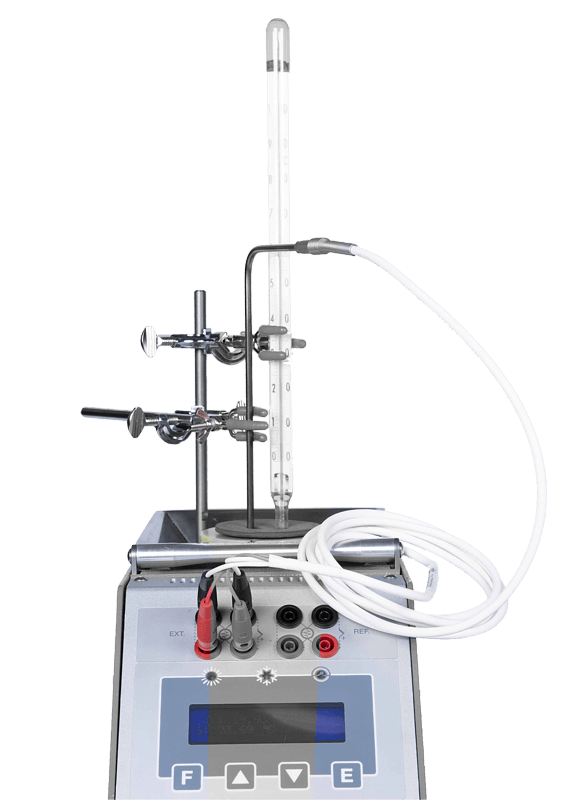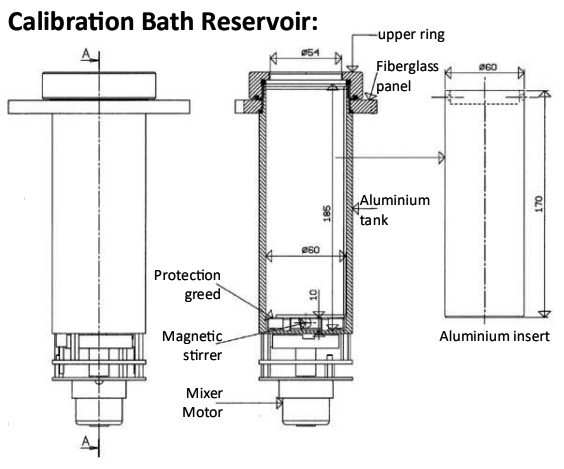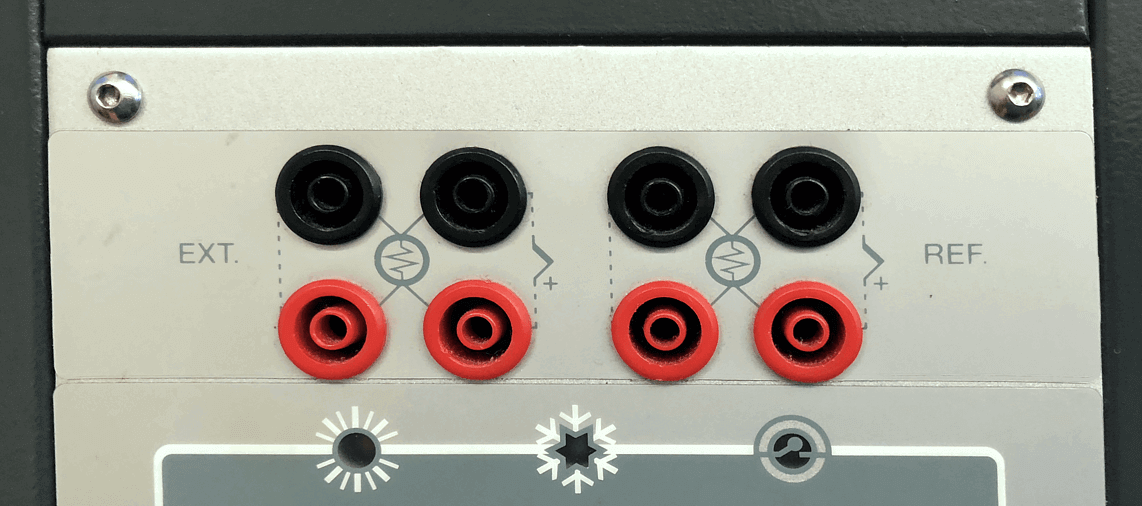LR-Cal FLUID 100-N
LR-Cal FLUID 100-N-2I
Portable temperature calibration bath
-18...+140°C
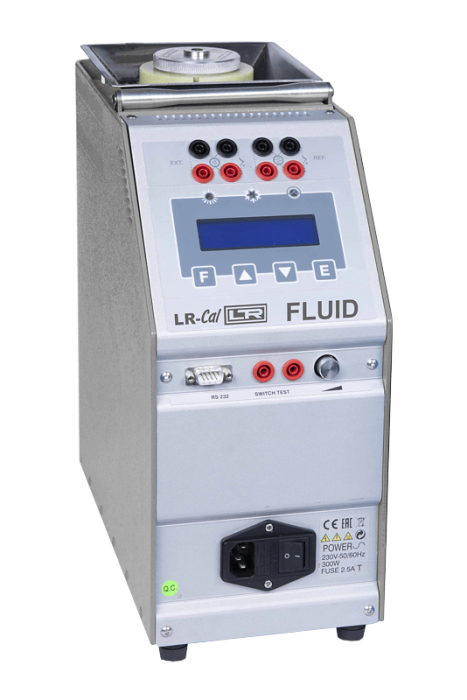

- Portable micro bath
- Temperature range -18°C...+140°C
- Accuracy ±0.15°C, stability ±0.02°C
- Calibration bath volume approx. 500 cm³
(60 mm diameter, 170 mm depth) - Option: Dry block inserts, Black Body insert
Description
LR-Cal FLUID 100-N description
The LR-Cal FLUID 100-N portable temperature calibration bath serves as a temperature source and reference instrument in one, for testing and calibrating all types of temperature measuring instruments. Various metal block inserts are also available.
- Optimal for calibration of glass thermometers and laboratory thermometers as well as temperature sensors with not exactly cylindrical shape
- Ramp function
- Thermostat tests
- Computer-controlled calibrations via computer interface
- Homogeneous temperature distribution due to adjustable magnetic mixer
- Option: dry block inserts
Device versions
LR-Cal FLUID 100-N device versions
The dry block temperature calibrator LR-Cal FLUID 100-N can be supplied in two different versions:
Version LR-Cal FLUID 100-N
Standard version
Order-Code FLUID100-N
Without inputs for resistance thermometer / thermocouples
Version LR-Cal FLUID 100-N-2I
Version with 2 measuring inputs for resistance thermometers Pt 100 (2-, 3- or 4-wire) or Pt 1000 as well as thermocouples incl. cold junction compensation types B, E, J, K, N, R, S and T.
Order-Code FLUID100-N-2I
The signals from up to two external temperature sensors can also be displayed.
Extended scope of delivery:
Electrical connection cables, plugs/terminals for the electrical connections.
| Accuracy (maximum deviation) of the two measuring inputs for device version "-2I": | ||||||||
|---|---|---|---|---|---|---|---|---|
| Pt 100 or Pt 1000 | at -40°C: | ±0.09°C | at 0°C: | ±0.08°C | at +150°C: | ±0.11°C | at +300°C: | ±0.14°C |
| Thermocouple type B | at +950°C: | ±0.97°C | at +1050°C: | ±1.03°C | at +1200°C: | ±1.12°C | ||
| Thermocouple type E | at -40°C: | ±0.42°C | at 0°C: | ±0.40°C | at +350°C: | ±0.61°C | ||
| Thermocouple type J | at +200°C: | ±0.52°C | at +450°C: | ±0.67°C | at +700°C: | ±0.82°C | ||
| Thermocouples types K, N, R and S | at +400°C: | ±0.64°C | at +700°C: | ±0.82°C | at +1000°C: | ±1.00°C | ||
| Thermocouple type T | at -40°C: | ±0.42°C | at 0°C: | ±0.40°C | at +350°C: | ±0.61°C | ||
Specification
LR-Cal FLUID 100-N specification
| Description: | Data: | |
|---|---|---|
| Temperature range (at +20°C ambient temperature) | -18°C...+140°C | |
| Temperature indication | Accuracy±0.15°C Resolution 0.01°/0.1° (°C or °F) |
|
| Stability of regulated temperature | ±0.02°C | |
| Heating from ambient temperature to 140°C, incl. stabilization | approx. 55 minutes | |
| Cooling from 140°C to ambient temperature, incl. stabilization | approx. 50 minutes | |
| Uniformity of temperature (at 40 mm insertion depth) | radial: ±0.07°C (at 140°C); axial: ±0.05°C ±0.03°C | |
| Calibration fluid | Silikone oil 200C5 | |
| Reservoir | Depth 170 mm x diameter 60 mm | |
| Power supply | 230 VAC (optional 115 VAC) | |
| Power consumption | 300 VA | |
| Interface | RS232 | |
| Fluid reservoir material | Aluminium | |
| Fluid reservoir volume | approx. 500 cm³ | |
| Housing material | metal | |
| Weight | approx. 11 kg | |
| Dimension | 160 x 360 x 350 mm | |
| Order-Code (standard version) | FLUID100-N | |
| Order-Code (-2I version with 2 measuring inputs) | FLUID100-N-2I | |
Scope of standard supply
LR-Cal FLUID 100-N scope of standard supply
- Temperature micro bath LR-Cal FLUID 100-N or LR-Cal FLUID 100-N-2I
- Spare fuses
- Cable for power supply
- Connection cable for thermostat tests
- Bottle with 500 cm³ silicone oil 47V10
- Holding device for glass thermometer
- Closing lid for transport purposes
- Carrying bag with shoulder strap
- Only version LR-Cal FLUID 100-N-2I: Electrical connection cable, plug, screw terminals red/black for the two measuring inputs
- Factory certificate (accuracy, stability, performance)
- Operating manual EN
LR-Cal FLUID 100-N options + accessories
DAkkS-certification
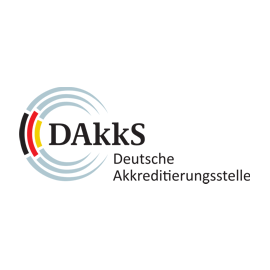
Option:
DAkkS certification
For the measuring chain consisting of display of the calibrator and internal reference sensor, 6 measuring points.
Windows-PCsoftware
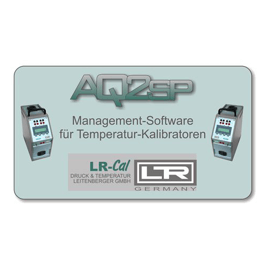
Accessory:
Windows-PC software Aq2Sp
incl. RS232 connection cable
(Delivery as password protected download link)
RS232 - USBconverter
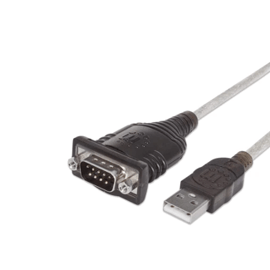
Accessory:
Interface converter RS232 to USB
Extension tube
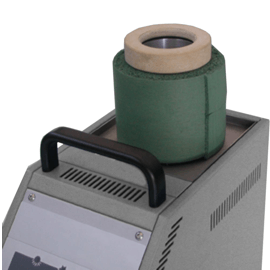
Accessory:
Extension tube
to increase the immersion depth
Total length 250 mm
Usable immersion depth 230 mm
Minimum temperature -9°C
Horizontal temperature uniformity ±0.1°C (measured 50 mm from the bottom)
Vertical temperature uniformity ±0.1°C (or ±0.15°C for temperatures below 0°C, measured 0...150 mm above the floor
When used with silicone oil 200C5:
Working range -9...+130°C
Cooling coil
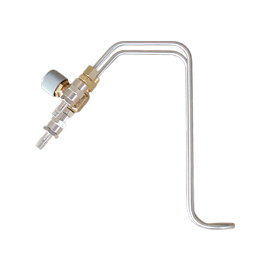
Accessory:
Stainless steel cooling coil
The cooling coil shortens the cooling time, and it can also shift the start of the working range of the calibrator downwards (but above 0°C). Requires fresh water connection.
Dry block insertwith 9 holes
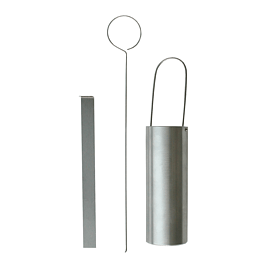
Accessory:
Dry block insert with 9 holes
4.0+4.0+4.5+5.5+6.5+6.5+8.5+10.5+12.5 mm
diameter
Dry block insertwithout holes

Accessory:
Dry block insert without holes
for self drilling
Sturdy caseAluminum
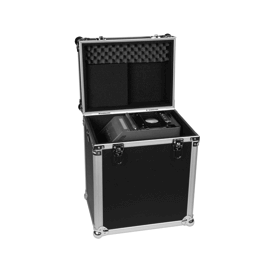
Accessory:
Sturdy case made of aluminum with molded foam inserts.
Dimensions: 450 x 280 x 380 mm
Weight: 4.8 kg
Shipping dimensions: 600 x 370 x 500 mm
Soft bagwith shoulder trap
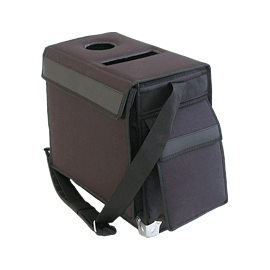
Spare part:
Carrying bag with shoulder strap
Dimensions: 410 x 220 x 380 mm
Weight: 1.45 kg
Shipping dimensions: 600 x 370 x 500 mm
(1 bag is included in the delivery of the calibrator)
Silicone oil200C5
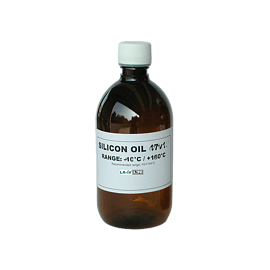
Accessory:
Bottle with calibration medium
500 cm³
Silicone oil 200C5
for range -40...+130°C
Silicone oil47V10

Spare part:
Bottle with calibration medium
500 cm³
Silicone oil 47V10
for range -30...+150°C
(1 bottle included in the scope of delivery of the calibrator)
Calibration liquids for LR-Cal temperature calibration baths
Applications:
- Thermostatic fluids for micro baths and thermostatic temperature calibration baths
Main Characteristics:
- Operating range -50...+200°C
- High stability
- Good thermal conductivity
- Nearly odourless
- Long service live
- Packaged in bottle or canister
- Different types for a wide range applications
- Low toxicity
- Low viscosity and corrosovity
Our thermostatic fluids are suitable for use in liquid thermostatic calibrators and thermostatic baths for applications from -50°C to +200°C.
The choice of thermostatic fluid is the most important aspect for obtaining the best results with regard to operation and temperature control of calibrators and baths.
These fluids have perfect thermodynamic characteristics to guarantee the best performance in the various fields of application, ensuring safe and reliable operation as well as optimum heat transfer efficiency.
Silicone-based fluids are chemically inert substances that do not affect metals, are resistant to weathering and, when used correctly, the very low formation of cracking and oxidation ensures a long service life.
Most of our thermostatic fluids are available in different containers: 500 cm³ bottles or 9 kg canisters (25 kg on request).
Temperature application ranges of the various operating fluids:
| Type of calibration medium (liquid) |
Usable range (1) |
Temperature above which fume hood should be provided (2) |
Fume burning (3) |
A viscosity of 10 cst exists at a temperature of (4) |
Freezing temperature (5) |
|---|---|---|---|---|---|
| Glycol 56% + water * | -40...+90°C | +70°C | >110°C | +20°C | -43°C |
| Silicone oil 47V5 | -40...+130°C | +110°C | +136°C | +5°C | -65°C |
| Silicone oil 47V10 | -30...+150°C | +120°C | +160°C | +20°C | -65°C |
| Silicone oil 47V20 | -20...+200°C ** | +130°C | +230°C | +60°C | -60°C |
| Silicone oil 47V50 | +30...+250°C ** | +140°C | +280°C | +160°C | -55°C |
| Silicone oil 47V100 | +50...+200°C ** | +170°C | >300°C | +200°C | -55°C |
| Silicone oil 47V150 | +50...+200°C ** | +190°C | >300°C | -/- | -55°C |
| Note: | Note text: |
|---|---|
| * | Mixture of 56% Glycol + 44% water |
| ** | In order to avoid gelling, it is recommended not to exceed a temperature of 200°C for a long time; even for fluids with wider operating ranges |
| (1) | Usable range The “usable range” of a calibration liquid is the temperature range in which it can be used under optimum conditions. The range may be limited by viscosity, flash points, freezing points, boiling points, evaporation rates, tendency to gel (or polymerize), etc. There is no liquid that covers extremely wide temperature ranges. Therefore, you should ideally use a separate calibration liquid for each temperature range. The recommended range is the one in which the viscosity is not optimal, but still reaches values that allow proper use. |
| (2) | Use of a fume hood The use of an exhaust hood when using temperature calibration baths prevents users from inhaling vapors from calibration liquids. It is best to use extraction devices near the access opening to the calibration bath. Vapors can otherwise settle on the mucous membranes of the eyes or on the skin, causing discomfort. Silicone oils can form benzene and formaldehyde when they decompose at high temperatures. The table shows the temperature above which an extractor hood should be used. |
| (3) | Flash point The table shows the temperature value at which the presence of an open flame can ignite vapours combustion. |
| (4) | Viscosity Viscosity is a measure of the flow resistance of a liquid. Viscosity increases with decreasing temperature. Kinetic viscosity is the ratio of absolute viscosity to density. This is measured in stokes and centistokes (cSt). 1 cSt = 1 stoke divided by 100. The higher the cSt, the more viscous or dense the liquid. Excessively viscous liquids place a strain on the stirring and pumping mechanisms of the calibration bath and do not transfer heat sufficiently. The table shows the temperature value below which the performance of the temperature calibration bath is no longer optimal. The equivalent value of water at 20°C is 1.1 cst. |
| (5) | Freezing point Silicone oils also change their state below a certain temperature by solidifying. The table shows the value at which the calibration fluid changes its state and solidifies. |
Other physical and chemical properties
Specific heat
The specific heat is the amount of heat required to raise or lower the temperature by 1 °C per kg. The specific heat, called CP, is expressed in Kcal/Kg °C. The energy required to heat or cool the calibration liquids depends on the amount of liquid contained in the calibrator in kg and its specific heat. A high specific heat value requires more energy to change the temperature, but offers greater temperature stability. The average CP of silicone fluids is 35 Kcal/Kg °C. The CP of water at 20 °C is equal to 1.
Thermal conductivity
Thermal conductivity is the ability of the liquid to transfer heat from one molecule to another. The better the heat transfer, the faster the liquid heats or cools. Better thermal conductivity improves the temperature uniformity in the reservoir of the calibration bath.
Expansion
All liquids have a coefficient of thermal expansion. This indicates how much the volume of a liquid changes (expands or contracts) when the temperature changes. Liquid expansion has an important impact on the safety, cleanliness and maintenance of temperature calibration baths. If calibrators are filled with too much liquid at a low temperature and then heated without regard to the increase in volume, they can overflow.
If too little liquid is filled in the reservoir, below the level of the heating elements, the temperature rise of the non-immersed part of the heating elements could ignite the liquid.
Gelation (polymerization)
The gelling temperature is the temperature at which silicone fluids oxidize, gel and turn into a viscous slurry. The main cause of this phenomenon is oxidation. Although silicone fluids can be used safely up to their flash point, the susceptibility to polymerization increases when used above their oxidation point. To prevent polymerization, it is advisable to keep the operating time above the oxidation point of the silicone oil used as short as possible in order to keep contaminants (salts, other oils and oxidizing agents) away. The calibration fluid must be replaced if it becomes dark, viscous or temperature unstable. It is important to limit the application time at high temperatures to prevent the oil from degrading and to extend its service life.
